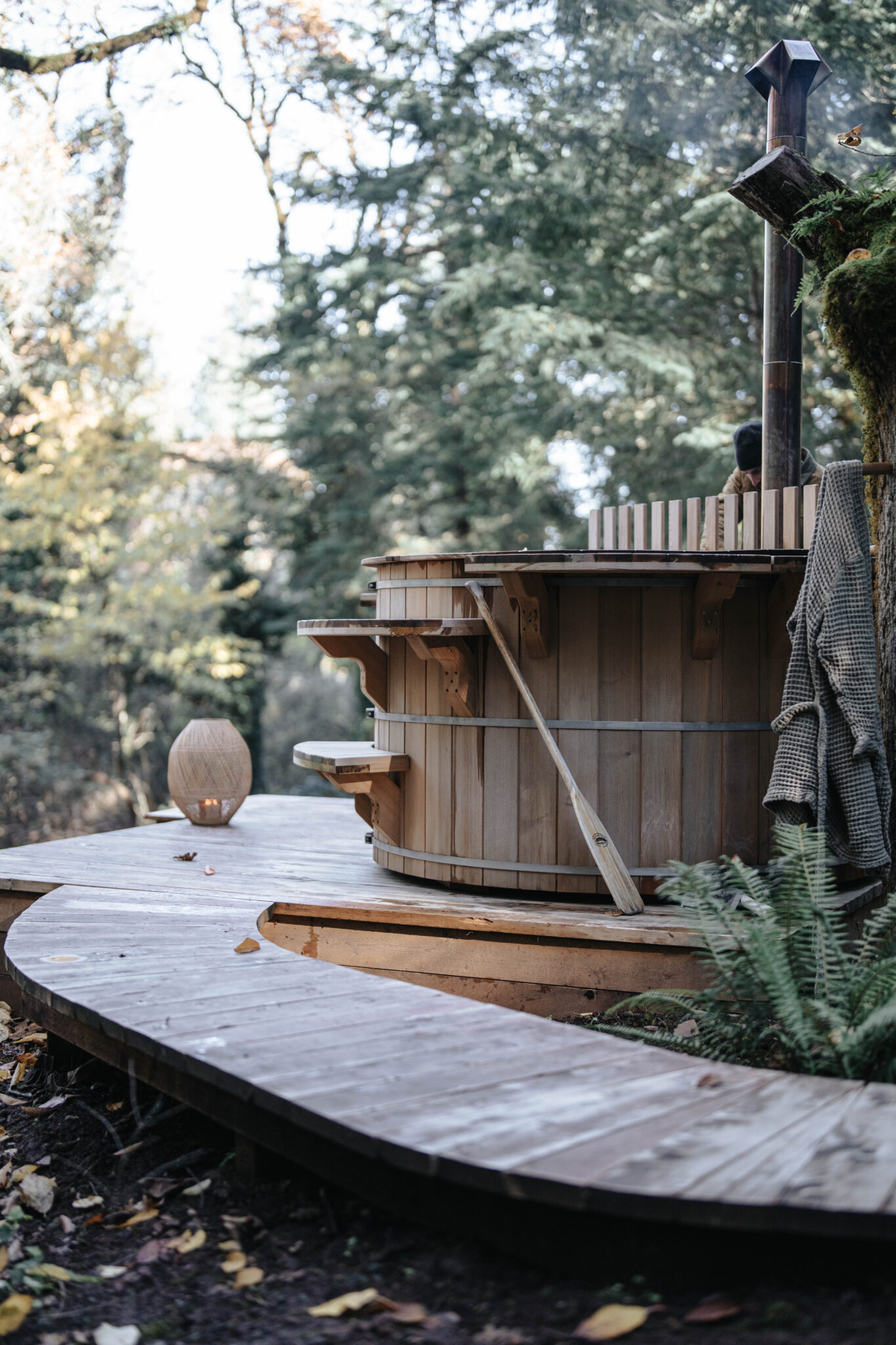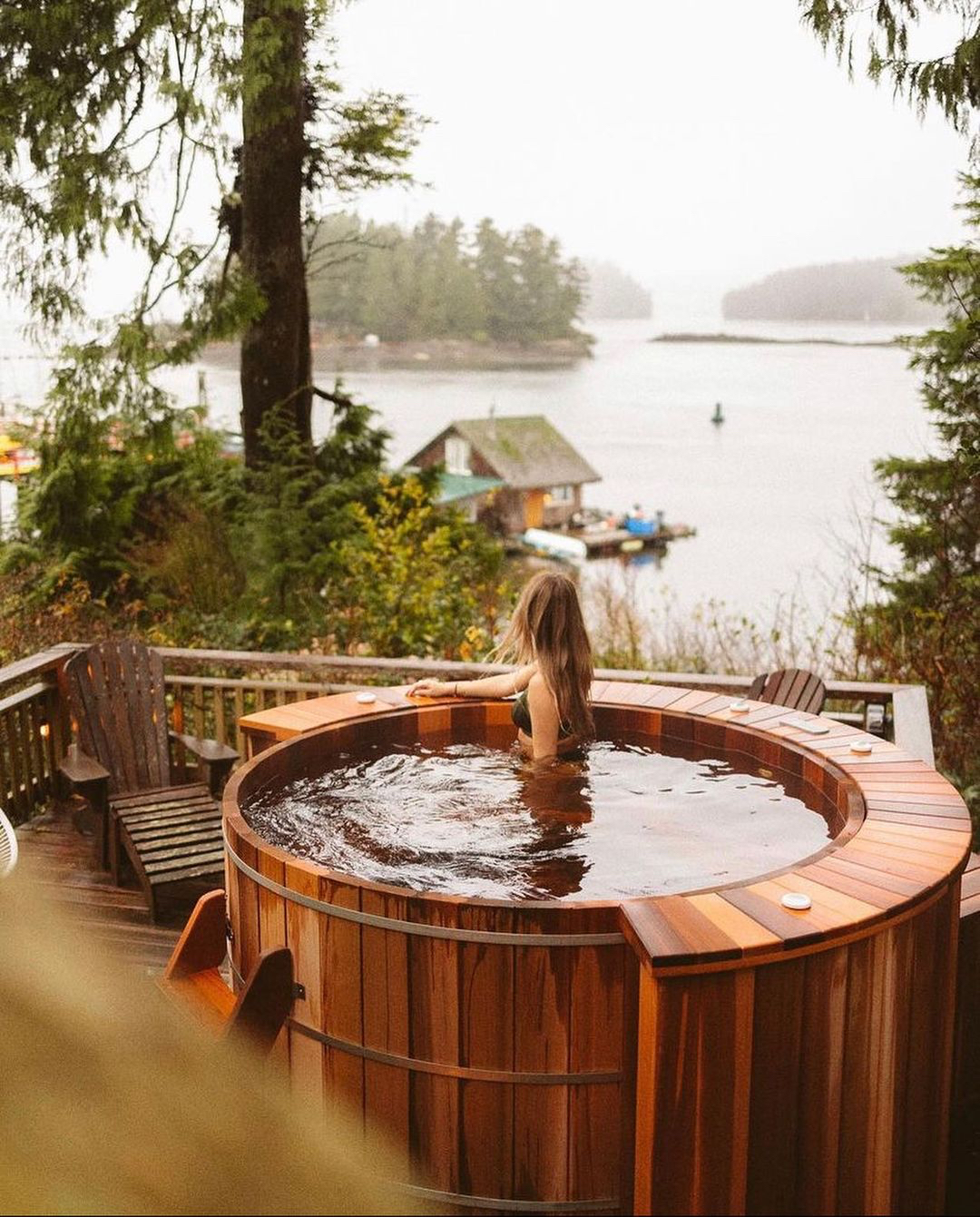
Why Choose a Cedar Hot Tub?
If you’ve been hunting for an option that can offer durability, beauty and natural health benefits, you’ve just found your perfect choice in a cedar hot tub.
A new cedar spa can be a significant investment, which makes longevity a key consideration for most. How does cedar stack up with traditional alternatives?
While acrylic hot tubs typically last 10-15 years, a premium quality vertical grain cedar hot tub can have a lifespan of 20 years or more. At Forest Cooperage we’ve been manufacturing hot tubs since the 1990’s and some of our customers have been using their tubs for more than 30 years!
The natural oils and resins in cedar make it highly resistant to rot and decay when wet, without requiring chemical staining. This translates to a more natural bathing experience, and the tub will silver naturally from exposure to the sun. To add additional protection for the exterior and preserve the warm wood colour, you can add a penetrating stain like Osmo.
Cedar is also a more sustainable choice than plastic alternatives. Not only does it last longer, it’s a renewable resource that can be composted or burned safely with a campfire at the end of its life.
For many homeowners, aesthetics are top of mind. Whether you want it to blend seamlessly into the natural beauty of your property or make a statement on your landscape, a cedar barrel hot tub offers versatility and style.

Factors to Consider Before Purchasing a Cedar Hot Tub
If all this has you feeling excited to bring a cedar hot tub into your life, the next step is to find the right setup for your space and your lifestyle. Here’s what to take into account:
Budget
The cost of a cedar hot tub can vary significantly depending on the quality of the manufacturer and the options included in your package.
Generally, the more capacity, features and accessories you add, the higher the price. Costs can also increase when you opt for custom sizing rather than choosing from standard options.
As with many things, you get what you pay for when it comes to cedar hot tubs. Clear, vertical grain cedar hot tubs come at a more premium price but last significantly longer and look more aesthetically pleasing than lower-quality wood options. We avoid using flat grain cedar because the fibers tend to lift with exposure to water, creating a less comfortable and less durable hot tub.
When budgeting for your hot tub, don’t forget to factor in delivery and installation costs. More on that below.
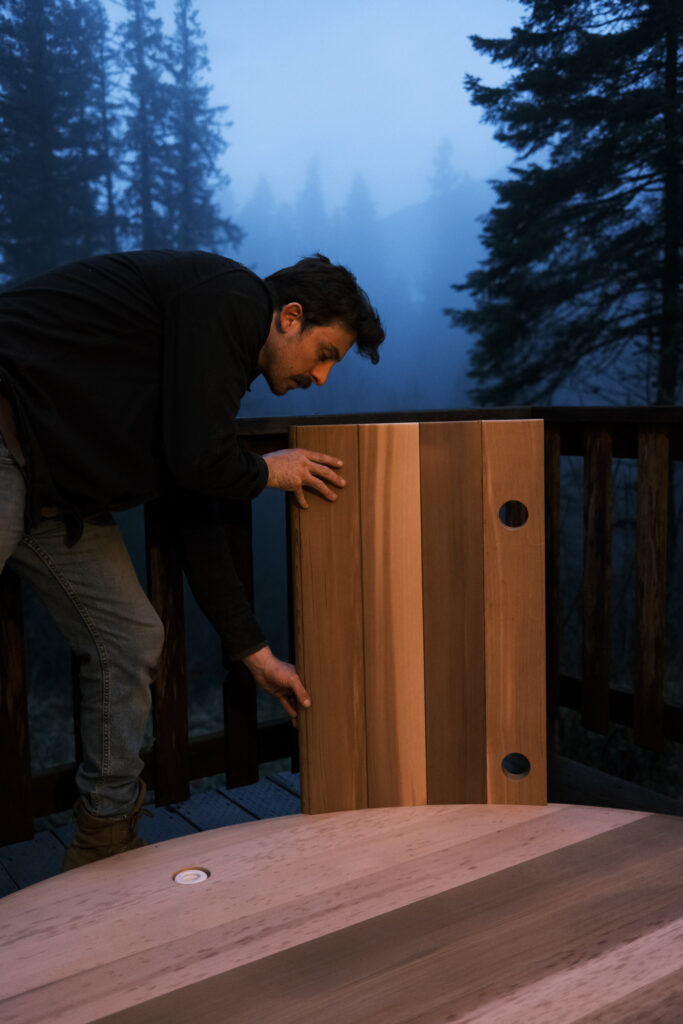
Capacity and Size
One of the perks of cedar barrel hot tubs is that they’re very space-efficient compared to traditional hot tubs, which tend to be bulkier.
The first thing to consider when choosing the capacity of your hot tub is the size of your location. Measure your space, taking into account that you’ll need room to access the plumbing and other equipment.
If you have a small or narrow space a Cedar Soaker Tub may be an ideal alternative.
Once you know your max capacity, choose your size based on your lifestyle and priorities. Do you really only need room for 2, or will you want space for family and friends, now or in the future? Do you have water restrictions or other considerations that could tip the scales toward a shallower tub, or are you looking for a luxuriously deep soak?
These questions will help you choose the right depth and size for your home and lifestyle.
Heating
Our hot tubs can be paired with one of four heat sources: electric, submersible wood stove, external wood stove or gas.
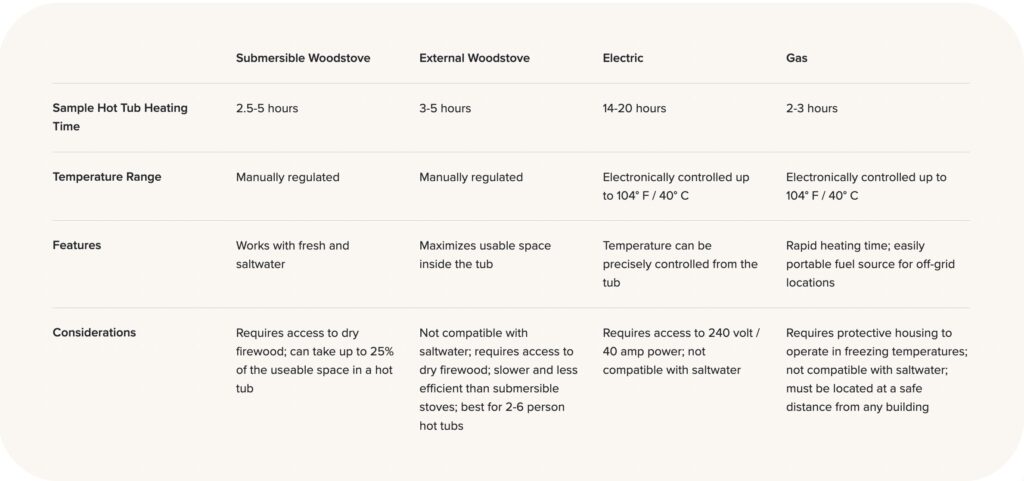
Electric-Heated Hot Tubs
The most common, convenient and affordable option is our electric heating package. Electric heating is a user-friendly heat source which allows for precise temperature control.
The drawback? Electric heating isn’t as fast as the other options, with an expected heating time of 14-20 hours or longer, depending on the ambient temperature and the size of your tub. On the upside, you can set your controls to maintain your desired temperature so you can soak anytime you feel like it.
If you have the electrical capacity, you can opt for an 11 kW heater, which is double our usual 5.5 kW heater size. It should heat a large 7′ diameter tub from a starting temperature of 60ºf/15ºc to 104ºf/40/ºc in about 8-10 hours, with an even faster heating time for smaller tubs.
Wood-Fired Hot Tubs
There’s something special about slipping into a hot tub fueled with wood. Wood-fired heating is a speedy option that doesn’t require access to electricity, but it does require a bit more effort and attention than electric heating. Many consider that an added benefit!
Our external woodstoves are made in Japan and are popular for our smallest hot tubs because they don’t affect the capacity of your tub. Keep in mind they do require external space for the heater to be placed safely away from combustibles.
If your tub is larger than 4’ in diameter or if you plan to use salt water in your hot tub, a submersible stove is your only option. These underwater woodstoves are made in Canada with marine-grade aluminum and have an edge over external woodstoves in heating time and efficiency. The downside is that they take up space within your hot tub (up to 25% in smaller tubs) reducing the total capacity.
Before choosing a wood burning hot tub, check your local fire regulations and clean air bylaws to ensure a woodstove is allowed. And of course, always ensure you’re following safe practices with use of a wood fired tub.
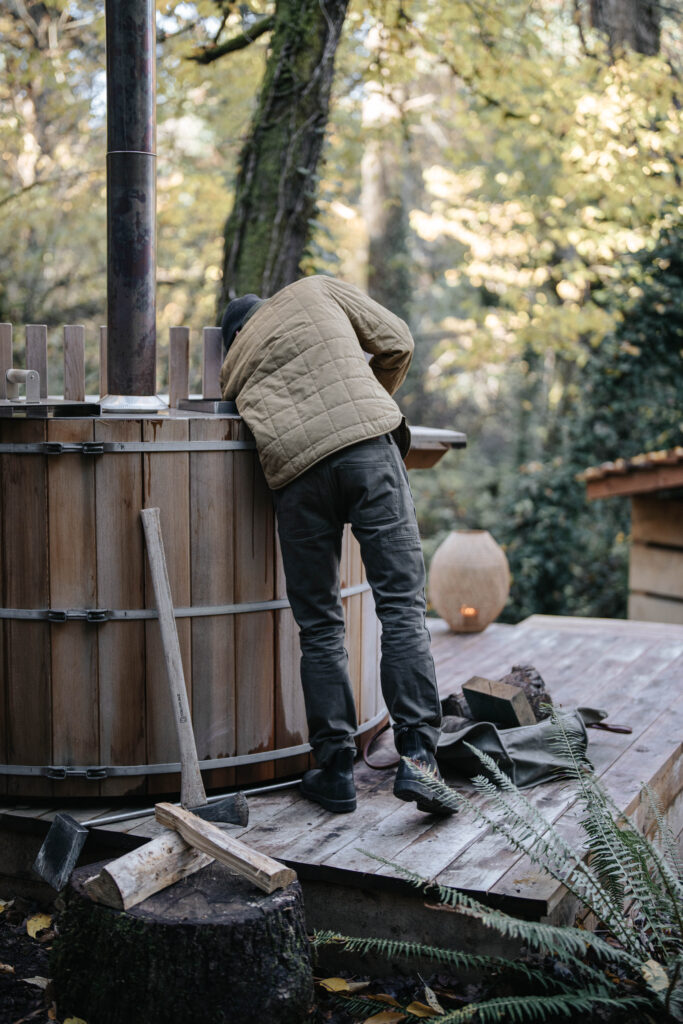
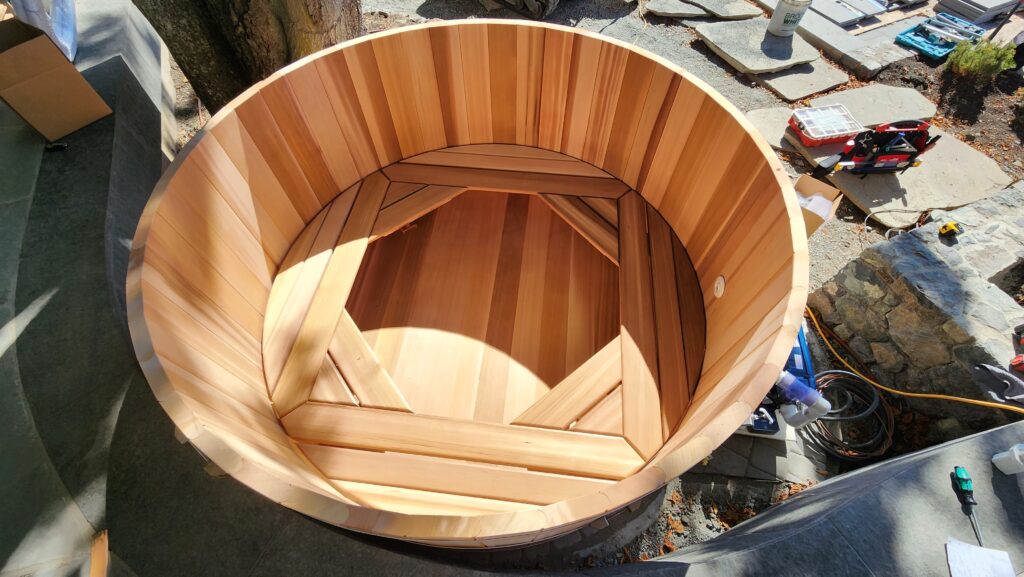
Location and Site Preparation
Choosing the right location for your tub is important for two reasons. First, it’s critical to find a place that’s safe, accessible and sturdy. You’ll need access to water, drainage, electricity (if required), and plenty of clearance for wood or gas-heated tubs.
Second, it pays to choose a spot where you’ll want to spend a lot of time. Pro tip: balance privacy, beautiful views and proximity to your home. While a secluded location has its perks, a hot tub right outside your door may get more use.
Once you’ve chosen your perfect spot, you’ll need to build a solid, level foundation. Your base will need to support thousands of pounds of weight and should have drainage to avoid flooding. Many customers pour a concrete foundation, but if you have a fairly flat surface you can use gravel and pavers to create a level base. It’s also possible to build a wooden deck for your tub, but be sure to work with a trusted contractor to ensure it can sustain the weight.
Learn how to prepare your foundation step by step.
Assembly and Installation
Building a cedar barrel hot tub is a rewarding process that requires just a few basic tools and a day or two of your time. We provide detailed instructions and troubleshooting support to make it as simple as possible, or you can hire a carpenter or contractor to get the job done.
The process of building your tub is laid out step by step:
- Step 1: Organize Your Supplies: keep your materials clean and dry until you’re ready to build, then lay everything out so that you can easily find what you need
- Step 2: Build the Base: Layout the 4×4 joists and connect them with deck screws to the locator boards.
- Step 3: Build the Floor: Install the drain into the pre-drilled drainage hole, then connect the two halves of the floor by lining them up and tapping them together with a rubber mallet.
- Step 4: Assemble the Staves: Connect the interlocking staves (wall boards) one by one, working counterclockwise. Follow the pencil line on the floor and gently tap the staves into place for a perfect fit.
- Step 5: Secure the Hoops: Loosely connect the metal strips into hoops and (ideally with the help of a second set of hands) slide the hoops into place one by one, tightening gently as you go.
- Step 6: Assemble the accessories: add any accessories like benches, steps or a ladder
- Step 7: Install your heater and plumbing: Follow the instructions to install your own woodstove, or have an electrician or certified spa technician install your heater
Learn more about how to build a cedar hot tub.
Electrical Requirements
To ensure the safety of your hot tub, it’s necessary to hire an electrician or certified spa technician to install your heater. You are working with electricity and water after all.
Most of our hot tubs include a 5.5 kW heater, which requires a 40 amp breaker with a 240v GFCI spa breaker panel. Our smaller tubs include a 4kW with a 30 amp breaker and a 240v GFCI spa breaker panel. More powerful 8 kW or 11 Kw systems are available for larger tubs, or if quick heating is desired and you have adequate electrical panel space.
Plumbing Considerations
Our hot tubs can be easily filled directly by a hose, but a spa technician or plumber is recommended to install more complex jetted systems.
If your hot tub is built fully or partially below a deck or patio, ensure you have room for access to the plumbing and space around the tub for airflow. You’ll also need overhead clearance to remove the filter for cleaning or replacement.
When you first fill your tub, check that your drainage is functioning properly, draining away from the tub. If it’s not, you may have issues with flooding around your tub which could cause damage to the tub or create slipping hazards.
Hot Tub Care and Maintenance
Using Your Hot Tub for the First Time
Even if you’ve done everything perfectly your cedar hot tub will leak at first. This is because the wood needs time to absorb moisture and expand to form a tight seal. This natural sealing process can take 1-6 weeks, but you can still use the tub while it seals as long as you maintain the water level over the woodstove or jets.
Start by adding a few inches of water to seal the floor then gradually increase the volume as the wood swells. Expect to see tea-coloured water from the natural tannins in the wood. This water is safe for bathing and the tannin colour will lessen with each water change. Note that it can take up to a year for the tannins to stop coming out of the wood.
We recommend the following drainage schedule for your new tub:
- Fill and hold water for one week. Drain.
- Fill and hold water for two weeks. Drain.
- Fill and hold water for 3 weeks. Drain.
- Begin a regular quarterly schedule of changing the water.
Routine Cleaning
Regularly draining and cleaning isn’t just important for sanitation, it can also extend the lifespan of your hot tub. Overtime oils and other materials can build up in your water, increasing the need for a higher chemical concentration.
To keep your tub clean, drain it completely every 3 months or more often with heavy use. We recommend using a soft nylon brush to gently clean the interior of the tub with a mix of 1 part vinegar to 3 parts water. Brush with the grain taking care not to damage the wood, then rinse thoroughly before refilling your tub and adding your chemicals.
For a mild abrasive, you can use baking soda to remove dirt and grime. Mix baking soda with water to form a paste and use a soft brush or sponge to scrub the surface. After cleaning, rinse the tub thoroughly to remove any residue.
If you have a filtration or sanitation system, clean them regularly according to your instructions to remove any buildup.
Seasonal Maintenance
Wood, electric and gas-heated hot tubs can all be used throughout the winter in freezing climates, but some extra care is required. If water freezes in your pipes, heater or in your tub it could cause serious damage, so you’ll need to drain your tub and equipment between uses or maintain the water temperature above freezing. Additional insulation around your exterior equipment is also recommended.
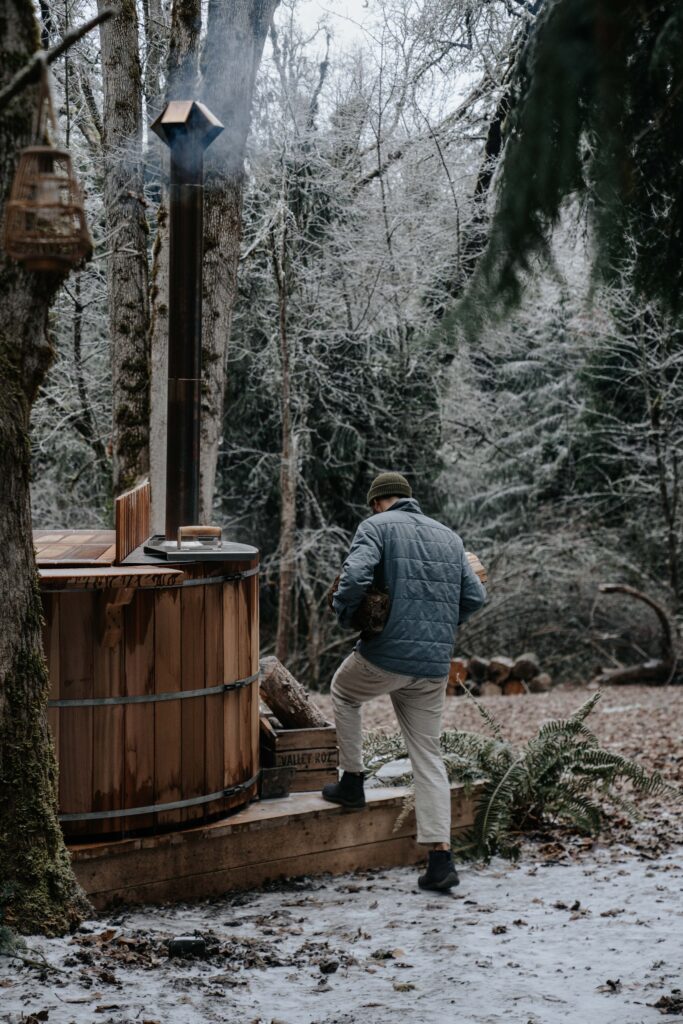
If you don’t plan to use your tub throughout the winter drain it completely, give it a clean then add a few inches of water to the bottom and add an algaecide to prevent algae growth. You’ll also need to drain and store any pumps, pipes, filters and electrical components.
When you’re ready to use your hot tub again in the spring, allow the ice to melt then drain and clean your tub before refilling.
Learn more about how to winterize a cedar hot tub.
Shipping and Delivery
All of our hot tubs are made to order at our factory on Vancouver Island. We ship our hot tubs flat-packed into a plywood crate for assembly onsite. Your hot tub can be shipped fully assembled if desired, but additional charges will apply, and plumbing and electrical will still need to be installed on site.
We offer worldwide shipping, and our hot tubs are distributed through Atelier Nordic in France and Rivera Hot Tubs in England. Our shipping carriers offer curbside delivery and in some cases, delivery closer to your site may be available.
Once the crate is dropped off you’ll need to move it to a dry location for storage until assembly. Because wood swells when wet, it’s essential to keep everything dry until fully assembled. You will likely need two people or a piece of equipment to safely move your hot tub. Depending on the size of the tub, the total weight can range add up to more than a thousand pounds.
When you request a quote for your hot tub, we can help you understand your shipping options and expected delivery times. Your final delivery costs will depend on the shipping rates at the time of delivery. You can find our estimated shipping costs here.
How To Choose The Perfect Hot Tub
There isn’t one hot tub that’s perfect for everyone, but there is one that’s perfect for you. From choosing the right size and accessories for your home and lifestyle to understanding what goes into building and maintaining your tub, there’s a lot to know!
By taking the time to learn about your options, you’re already on your way to finding a tub that you’ll be able to enjoy for decades.
We hope we’ve answered many of your questions about buying a cedar hot tub, but if there’s anything you’re still unsure about we’re here to help.

